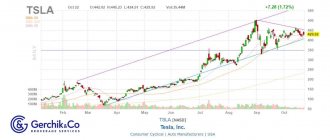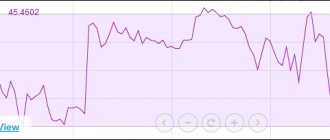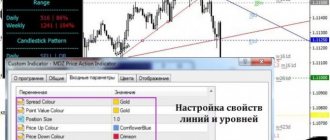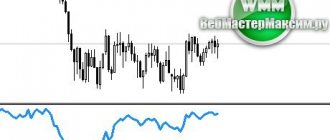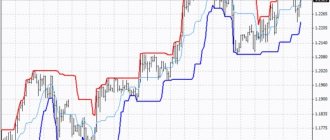In previous lessons, we looked at the general rules for selecting stocks and the algorithm for analyzing the P/E ratio. We continue to study indicators that will help you choose the most profitable stocks to make money.
Market to Book ratio (also called Price to Book ratio) is a financial ratio used to evaluate a company's current market capitalization relative to its book value.
- Market capitalization (market value) is the current price of a stock multiplied by the sum of all shares outstanding.
- Net book value is defined as total assets minus total liabilities. Essentially, it is the amount that will remain if the company liquidates all of its assets and pays off all of its liabilities. This value is determined based on the balance sheet.
In other words, this ratio is used to compare the company's net assets available to the selling price of its shares.
The market-to-book ratio (P/B ratio) is commonly used by investors to indicate the market valuation of a stock. This marker is useful in valuing companies that are largely composed of liquid assets, such as investment trusts, insurance companies, and banking companies.
This ratio is used to determine how much stock investors pay for each dollar of net assets. The P/B ratio is calculated by dividing a stock's current market price by its most recent book value for a given period.
Formula for calculating P/B
Formula for calculating the multiplier.
Book value is calculated by subtracting intangible assets and liabilities (current and long-term) from total assets.
Market value is calculated as the company's capitalization.
If the coefficient is <1, then we can conclude that the market values the company lower than its existing assets, i.e. the company is undervalued and can be considered as an investment object.
However, you need to keep in mind that if the ratio is less than 1, this does not mean that you should buy these shares. Perhaps the company has large debt obligations (short-term + long-term loans). There is a risk of bankruptcy.
The ratio can be understood in the same way as how much money investors will get if the company goes bankrupt. This is why it is important to look at your debt structure.
The indicator is often used to evaluate banks, since assets and liabilities almost always correspond to their market value.
Calculation of enterprise profitability using Price/Book Value Ratio
The common misconception about the industry average ratio and the overvaluation of an institution should be dispelled with an example. Let's start calculating. Remember that P/B is a pair of indicators. When used correctly, the values allow you to correctly evaluate the enterprise.
The assessment should begin by applying the formula P = Qs * Ps. We must decide on capitalization. To determine the total value of the company, you should multiply the number of shares available in the public domain by the value of the security on the market. As a result, we get capitalization in its pure form.
Now you can proceed to calculate coefficient B. How is the actual price indicator calculated? The available assets of the enterprise, formed from personal sources, are added up. The sum of the coefficient is formed from:
- authorized and additional capital;
- reforming the price of fixed assets;
- the institution's reserves provided for by law;
- undistributed profits;
- the difference between funds received from the sale of assets and their nominal price.
All of the above information is in the balance sheet of the enterprise. It can be used to calculate the ratio of assets to net debt of a company.
Standard value (what it shows)
The optimal P/B value is in the range of 1-5. If the multiplier is greater than 5, then this indicates that the stock is overvalued, and if it is less than 1, then it is undervalued. Sometimes in the literature you can find statements about overvaluation/undervaluation of shares with values of P/B>2 and P/B<1, respectively.
| Multiplier value | Description |
| P/B<1 | The company is rated as expensive. Investor overpays for shares |
| P/B=1 | The company is fairly valued |
| P/B<1 | The company is undervalued by the market. An investor buys shares below their intrinsic value |
| P/B<0 | The company's liabilities exceed its assets. The emergence of bankruptcy risk |
| P/B>5 | The company's shares are highly overvalued. |
Advantages and disadvantages
(+) Allows you to identify undervalued stocks.
(+) Easy to calculate.
(+) Stability and independence from market conditions. For example, the P/S ratio is unstable due to the presence of net profit in the formula.
(-) The multiplier is not able to show the investor the efficiency of the company (its profitability and turnover).
(-) The multiplier is applied incorrectly for high-tech IT companies, where a large share of assets is made up of intangible assets (licenses, patents).
(-) Cannot be used for companies from different sectors of the economy.
(-) Cannot be used for high-tech companies where the balance sheet has a high share of intangible assets.
(-) Cannot be used to compare companies using different forms of accounting statements (RAS, IFRS, GAAP).
A practical example of calculating P/B for PJSC Aeroflot
For a deeper understanding of the coefficient, let’s consider its calculation using the example of Aeroflot PJSC (AFLT). First, let's calculate the company's capitalization. To do this, go to the Moscow Exchange moex.ru → enter the company ticker “AFLT” in the search bar → the company card shows the size of capitalization.
The first way to find out the capitalization of a company is through the Moscow Exchange
The second way to find a company's capitalization is to use TradigView.com. We go to the Russian stock market, enter the Aeroflot ticker and look at the capitalization.
The second way to find out the capitalization of a company is through the Moscow Exchange
Aeroflot capitalization (AFLT) = RUB 86,694,708,300.
Next, we move on to determining the book value of the company. It can be found on the website in the financial reporting section. Units of measurement in the balance sheet thousand rubles. Therefore, let’s not forget to add 1000 at the end.
Financial statements according to RAS of PJSC Aeroflot
Aeroflot assets
Long-term liabilities in the balance sheet of the enterprise
Short-term liabilities in the balance sheet of the enterprise
Book value = Assets – Long-term liabilities – Current liabilities = line 1600 – line 1400 – line 1500
Book value of Aeroflot ( AFLT) = 206,019,591 – 9,372,067 – 143,060,020 = 53,587,504 thousand rubles.
P/B = 86 694 708 300 / 53 587 504 000 = 1,6
The P/B multiple for Aeroflot is 1.6, the company is slightly overvalued by the market.
About P/BV in simple words
The P/BV ratio, also known as P/B, in dry financial language, denotes the correspondence between the value of securities on the market and the current price of net shares (minus costs in the event of immediate liquidation).
In simple words, this is the ratio of the pricing policy of one security of the organization’s material reserves. The latter is the remains of the company’s property after the sale of the establishment and settlements with creditors.
The numerator P reflects the value of shares on the world market. The denominator coefficient B is the actual price indicators. Taken together, the formula shows the result that a potential investor is willing to pay.
Application of P/B for Russia
One of the directions of application of the P/B indicator can be used to assess the investment potential of a country. For assessment, you can use the service on the website StarCapital.de → current data
Application of P/B for Russia
Russia ranks 1st in terms of P/B compared to other countries in the world. For Russia, the P/B indicator is 0.8, which indicates that the Russian stock market is undervalued.
Option 1
According to the SAC report as of June 30, 2021:
P/B = Share price / BVPS = 23.58 / 30.66 = 0.77
P/B Bank of America
BVPS = Total Shareholder's Equity / Total Shares: 265.637 / 8.6641 = 30.66 (no Preferred equity) (see below)
Net book value BAC
[service] Where to look at P/B for foreign companies
To evaluate American companies, we will use the Finviz.com service.
Using the finviz.com service to evaluate the p/b of foreign companies
When choosing a company, you must also look at the sector (industry), country and other fundamental indicators.
Let's select a screener, then fundamental indicators and filter by P/B ratio less than 1. This way we can find undervalued shares.
What is the P/B multiple and what does it show?
The P/B ratio (or also called P/BV - Price/Book Value ratio) is an indicator that reflects the ratio of the market value of shares and the current value of net assets (Net Asset) minus all expenses, in the event of immediate liquidation.
Simply put, the P/B multiple is the ratio of the value of all shares to the company's inventory. And by material reserves we mean everything that will remain with the owners after the sale of the company and the repayment of all the company’s obligations.
Also, one of the functions of this coefficient is how much an investor is willing to pay for the property of the enterprise per 1 share. In other words, it shows how many assets (in monetary terms) the investor acquires for each invested ruble (dollar, etc.).
conclusions
The multiplier allows you to quickly assess whether a company is overbought/oversold in relation to similar companies in the industry. It is incorrect to apply for high-tech companies with a high share of intangible assets. For a more accurate assessment, it is better to calculate it over several periods for companies in the same segment (industry).
| Business valuation | Financial analysis according to IFRS | Financial analysis according to RAS |
| Calculation of NPV, IRR in Excel | Valuation of stocks and bonds |
Why is the P/BV ratio so important?
In fact, the P/BV ratio (P/B) is the ratio of return on equity (ROE) to the required return.
,
where P is the company’s capitalization;
BV – book value;
E – the company’s net profit;
ROE – return on equity;
r – required return (market rate).
Let's consider the components of this formula in more detail .
The price/earnings ratio ( P/ E ) shows the number of years it takes for an investment in a particular business to pay off. If we “invert” this ratio, we get the E/ P (the ratio of net profit to the value of the company), which represents the rate of return (in percent per annum) that the investor will receive in the form of net profit. Let's denote this rate as r . In fact, r is the required market return on investment in a particular business.
E/BV ratio shows how much net profit was received per ruble of equity capital, that is, it is the efficiency (profitability) of equity capital, or, in other words, ROE (return on equity).
So, ROE is the rate at which shareholders' funds work in the company, and r is the market rate of return. Thus, P/BV (P/B) reflects the performance of shareholders' funds in comparison with the market return that an investor can earn.
The more efficiently equity funds are used, the greater the gap between the rate at which shareholders' funds work in the company and the required rates of return on the market may be.
In connection with this feature of the P/BV (P/B) ratio, it is worth considering one of the common misconceptions present in the stock market: “if the P/BV ratio is greater than the industry average, then the company is overvalued by the market.” In reality this may not be the case. If a company is predicted to have a consistently high level of ROE (above r ), then it is absolutely normal that its P/BV ratio will be higher than the industry average; this only means that shareholders’ funds in this company are working more efficiently than in other companies in the same industry. Knowing this, you can not be afraid to purchase shares of companies with a high P/BV (P/B) ratio, because now you know that it expresses the efficiency of using shareholders' funds in relation to the required rates of return in the market.
